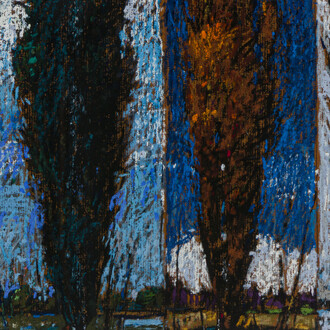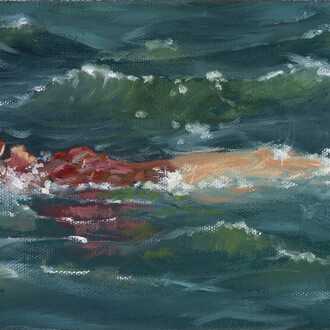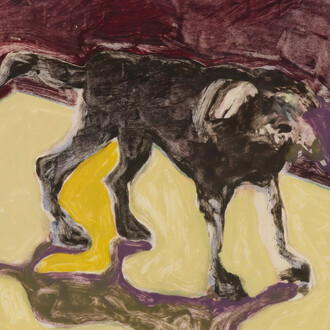During the mid-Twentieth Century, American painter, Maurice Golubov (1905- 1987), vigorously pushed the boundaries of Abstract Art. Simultaneously, he developed a unique and intrinsic form of art, metaphysical in nature, that explored his quest for spirituality. This involved the pursuit of an alternate dimension to the observable world that, in his mind, captured a greater essence of reality in a realm beyond the merely physical, beyond what could be expressed only in the three dimensions of length, width, and depth, into a realm that he came to call the “Fourth Dimension.”
Golubov was born near Kiev in 1905 to Orthodox Jewish parents who had envisioned their son becoming a Rabbi, although at an early age he turned his attention to making art. As a young boy, he was steeped in the studies of Yiddish, Hebrew, the Talmud, and medieval Jewish Mysticism - all of which had a life-long influence on his art.
The family escaped Russia in 1915 and moved to New York in 1917. There, Golubov took classes with the renowned artist John Sloan and studied at the National Academy of Design where, in 1922, he was awarded the Silver Medal for excellence.
At the Academy's school, Golubov began making small abstractions in the margins of his school work which was the beginning of his effort to fulfill a curiosity he’d had since childhood to create a visual representation of the invisible world he could sense and feel — things that were real and yet unseen. He describes his progression as follows:
I became fascinated by that mysterious world ... about the Chassidic world I grew up into ... I started to imagine and to draw things of that mysterious world of the mind. Abstraction became my true realism ... my burning interest was to explore the mysteries of the unseen world which somehow was very real to me even though I could not touch it or see it ... I seriously started to find symbolic means to be able to express all this wonder in pictorial terms ... to enter the fourth dimensional hidden world behind the third...
Golubov's work was influenced by his friendships with other New York-based artists — Max Weber, Stuart Davis, Arshile Gorky, Milton Avery, and David Smith. In 1941, the important abstract artist, Alice Trumbull Mason and George L.K. Morris saw a solo show of Golubov's work and invited him to join the influential American Abstract Artists group.
In 1943, Golubov had the first of three solo shows at the Mint Museum in Charlotte, North Carolina and in the late 1940s, the legendary art dealer, Betty Parsons, gave the artist two solo exhibitions. Recognition of Golubov's work continued with its inclusion in the Whitney Museum’s 1951 Annual Exhibition of Contemporary American Sculpture, Watercolors, and Drawings. That same year, his work was exhibited at the Whitney Annual of American Painting. In 1962, Golubov’s work was featured in the Museum of Modern Art's "Recent Painting USA: The Figure."
In 1975, the renowned Tibor de Nagy Gallery in New York began representing his work and, in the late 1970s, he was invited to participate in several group exhibitions focusing on geometric abstraction in American art at the Newark Museum, Annely Juda Fine Art (London), and the Museum of Fine Arts, Houston.
Golubov was given his first major museum retrospective in 1980, which traveled to several museums including the Jewish Museum in New York City. In the accompanying catalog, Susan C. Larsen sums up the great appeal of Maurice Golbov's work:
One of the most welcome and refreshing aspects of Golubov’s art is its unabashed complexity, its density which runs counter to the reductive emphasis in painting over the past several decades. His forms are stacked and interwoven, piled upon each other. Plane overlaps plane until all sense of location and scale is erased, the painting becomes a complex world unto itself.
Decades later, Golubov's work continues to retain a freshness, a liveliness, and an energy that is both playful and serious, sensuous and thoughtful - and most of all - passionate.















